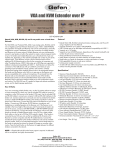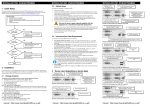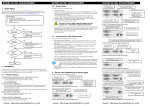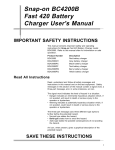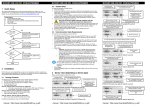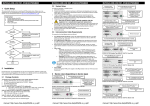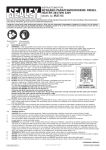Download DDXI V1.00 DIGITAL DVI/VGA-KVM
Transcript
DDXI V1.00 DIGITAL DVI/VGA-KVM-EXTENDER DDXI V1.00 DIGITAL DVI/VGA-KVM-EXTENDER 2.2 System Setup Connect to PS/2 keyboard and mouse using supplied cables 1 Quick Setup To install your DDXI - DVI KVM Extender system: This section briefly describes how to install your KVM extender system and optimize the video signals. Unless you are an experienced user, we recommend that you follow the full procedures described in the rest of this manual. Refer to the command summary when following this procedure. 1. 2. 4. Connect Remote unit to KVM. Connect Local unit to CPU or switch. Connect Local and Remote units with matching interconnection cable (CATx, Multimode or Singlemode fiber). Power up the system. 3. 4. No Yes Connect the interconnect cable to the INTERCONNECT socket(s) as shown below (K4391W), (K437-1W/K438-1W) or (K442-3U/K443-3U). Connect the 6V power supply to power the unit. Only use the power supply originally supplied with this equipment or a manufacturer-approved replacement. Do you have a flat screen (TFT)? 5. Yes Carry out the Monitor Setup procedure (please refer to its manual and see page 40 in this manual). Programming connector – for firmware upgrades DVI-I Connector – DVI/VGA output – connect to Remote console monitor Connect to 6V Power supply Using the supplied CPU KVM cable(s), connect the keyboard, monitor(s) and mouse connectors on the computer (or KVM switch) to the corresponding connectors on the Local unit as shown below (K439-1W), (K437-1W/K438-1W) or (K442-3U/K443-3U). Ensure that you attach the keyboard and mouse connectors to the correct ports. The keyboard connector is purple; the mouse connector is green. INTERCONNECT – carries video and data signals – connect to Remote unit Connect to Local console keyboard and mouse Connect to CPU’s keyboard and mouse sockets If your PC does not have a PS/2 mouse port, an active serial converter will be required 6. 7. 8. Do you have a DVI source? Switch off all devices. Connect your keyboard, monitor(s) and mouse to the Remote unit as shown below (K439-1W), (K437-1W/K438-1W) or (K442-3U/K443-3U). K437/K438-1W Remote Unit No Do you have a DVI monitor? INTERCONNECT – carries video and data signals – connect to Local unit with Fibre cable These ports may also be attached to the CPU side of a KVM switch in order to have a Remote CPU. However, if you are attempting to use the extender between cascaded KVM switches this may not work. Please contact Technical Support to discuss your application. Install system 1. 2. 3. DDXI V1.00 DIGITAL DVI/VGA-KVM-EXTENDER For a dual access system, connect the keyboard, mouse and monitor for the Local console to the appropriate ports on the Local unit. The ports may also be used to feed into a KVM switch. Connect the Interconnection cable from the Remote unit to the INTERCONNECT socket on the Local unit as shown below (K439-1W), (K437-1W/K438-1W) or (K442-3U/K443-3U). Power up the system. Connect 6V Power supply Connect to Local console monitor Yes Connect to CPU video card output DVI-I Connectors 3 Device View (depending on device type) Programming connector – for firmware upgrades K437/K438-1W Local Unit No Carry out VGA Input Setup procedure (please follow the instructions on page 42). Connect to PS/2 keyboard and mouse using supplied cables INTERCONNECT – carries video and data signals – connect to Local unit with CATx cable 4xUSB connectors for keyboard, mouse and other devices, for example, printer Connect 5V Power supply for USB high power INTERCONNECT – carries video and data signals – connect to Local unit Done 2 Installation For first-time users, we recommend that you carry out a test placement, confined to a single room, before commencing full installation. This will allow you to identify and solve any cabling problems, and experiment with the KVM extender system more conveniently. Programming connector – for firmware upgrades DVI-I Connector – DVI/VGA output – connect to Remote console monitor Connect to 6V Power supply Programming connector – for firmware upgrades K439-1W Remote Unit 2.1 Package Contents You should receive the following items in your extender package (all types) If anything is missing, please contact Technical Support: • Extender Local/Remote unit. • 2x 6V DC 12W universal power supply for Local/Remote unit. • 2x DVI-I to VGA adapter (DVI-I dual link male to HD15 female) connector. • 1x VGA to DVI-I adapter (HD15 male to DVI-I dual link female) connector. • Programming cable (DB9 female to RJ11 4p4c). • User manual (Quick Setup). • 2x German-type power cord. All PS/2 models are supplied with: • KVM CPU cable set (1.8m) with PS/2 (6-pin mini-DIN male-to-male) keyboard and mouse connector and DVI-I video (DVI-I dual link male-to-male) connector All USB types are supplied with: • DVI-I video cable (DVI-I dual link male-to-male) • USB cable (USB type A to type B) • 5V DC 12W universal power supply for Remote unit (only required when connecting two or more High Power USB • US-type power cord (additional) manual : http://www.ihse.de/pdf/b437-1w_e.pdf INTERCONNECT – carries video and data signals – connect to Remote unit Connect to 6V Power supply Connect to Local console monitor Connect to Local console keyboard and mouse Connect to CPU video card output DVI-I Connectors DVI-I Connector – DVI/VGA output – connect to Remote console monitor Connect to 6V Power supply K439-1W Remote Unit Connect to CPU’s keyboard and mouse sockets Programming connector – for firmware upgrades K439-1W Local Unit INTERCONNECT – carries video and data signals – connect to Remote unit Connect 6V Power supply Connect to Local console monitor USB input – connect to CPU Connect to CPU video card output Programming connector – for firmware upgrades DVI-I Connectors K442-3U/K443-3U Local Unit manual : http://www.ihse.de/pdf/b437-1w_e.pdf manual : http://www.ihse.de/pdf/b437-1w_e.pdf DDXI V1.00 DIGITAL DVI/VGA-KVM-EXTENDER 3.1 DDXI V1.00 DIGITAL DVI/VGA-KVM-EXTENDER You can adjust the following properties using the OSD: Diagnostic LEDs Each Extender unit is fitted with four indicator LEDs: Communication Error, Link Status, Device Ready and Video Signal. The Indicator LEDs are located in the same positions on all models in the DDXI - DVI KVM Extender range. The Communication Error and Link Status LEDs are to the left and right, respectively, of the Interconnect sockets. The Device Ready and Video Signal LEDs are next to the Power socket. As an example, the location of the LEDs is shown below for K439-1W Remote and Local units: Communication Error DDXI V1.00 DIGITAL DVI/VGA-KVM-EXTENDER Link Status Communication Error Link Status Adaptation to analog signal sources (VGA/RGB) – see also manual, page Fehler! Textmarke nicht definiert.. Color temperature Brightness/contrast Saturation OSD operation, factory reset. • • • • • 4.1 Opening the OSD You can access the OSD in two ways: Using the keyboard attached to the Remote Unit: Using our small WINDOWS™ program with a serial connection to the programming port of the LOCAL UNIT. While the OSD is active, the mouse is locked and only menu keystrokes are allowed at the keyboard. To indicate that the OSD mode is active, the status LEDs (Num Lock, Caps Lock and Scroll Lock) are flashed. There is a summary of OSD commands. • • 4.1.1 Using the keyboard attached to the Remote Unit Video Signal (Green) Figure 1 Device Ready (Red) Device Ready (Red) Video Signal (Green) Diagnostic LEDs on Remote (left) and Local (right) units Type the following key sequence at the Remote console keyboard: <Ctrl> + <Shift> + < I > Note. On some keyboards, <Ctrl> is replaced by <Strg>. DDXi V1.00 DVI/VGAKVM-Extender To navigate within the OSD: LED Appearance Diagnostics Communication Error Off Flashing No communication error for >60 minutes Indicates number of communication errors during previous 60 minutes: slow medium fast 10-100 (CATx) 100-1000 (CATx) >1000 (CATx) 1-2 3-10 >10 (Fiber) (Fiber) (Fiber) Error counter cleared automatically 60 minutes after previous communication error. Link Status On Flashing Link connection is locked Interconnection cable not connected or not functioning Device Ready (Red LED) Off On Device not ready Device ready Video Signal (Green LED) Off On No video signal or valid mode detected Attached and valid mode detected • • • • Use the left and right arrow keys to highlight a submenu and/or function. Press the <ENTER> key to select the highlighted submenu or function. Select the Exit icon to go back to the previous menu level. Press the <ESC> key to exit the OSD mode. 4.1.2 Using our WINDOWS™ program attached to the Local Unit On all devices, you can use our small WINDOWS™ program, running on a WINDOWS™ computer for OSD access: • Download the program from our server • • Connect the programming cable to the programming port of the Local unit. Connect the programming cable to the serial port of your computer, where the program is running. Start the program and follow the on-screen instructions. Type in the following key: <ENTER> • • When the OSD starts, it displays information about the attached device and firmware version, for example: 4 Device Control If you are using the DVI output from your video card and the DVI input to a TFT monitor, no adjustment should be required. In other cases, when the video signal is converted between analog and digital formats, either by the Local unit and/or the monitor, you may need to optimize the video signal using the Extender’s on-screen display (OSD). Version information Screen resolution and refresh rate Modul Name Version Date Type : K437-1W K438-1W K439-1W K442-3U K443-3U (Quick Setup) : DVI-KVM-12lo : Vers.1.3 : 03/05/15 To navigate within the OSD: • Use the <L> and <R> keys to highlight a submenu and/or function. • Press the <S> key to select the highlighted submenu or function. • Select the Exit button to go back to the previous menu level. Press the <X> key to exit the OSD mode. Main menu icons Submenu/command icons Menu title Figure 2 OSD Utility manual : http://www.ihse.de/pdf/b437-1w_e.pdf manual : http://www.ihse.de/pdf/b437-1w_e.pdf manual : http://www.ihse.de/pdf/b437-1w_e.pdf


